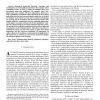Free Online Productivity Tools
i2Speak
i2Symbol
i2OCR
iTex2Img
iWeb2Print
iWeb2Shot
i2Type
iPdf2Split
iPdf2Merge
i2Bopomofo
i2Arabic
i2Style
i2Image
i2PDF
iLatex2Rtf
Sci2ools
TCSV
2008
2008
A Framework for Evaluating Stereo-Based Pedestrian Detection Techniques
Automated pedestrian detection, counting, and tracking have received significant attention in the computer vision community of late. As such, a variety of techniques have been investigated using both traditional 2-D computer vision techniques and, more recently, 3-D stereo information. However, to date, a quantitative assessment of the performance of stereo-based pedestrian detection has been problematic, mainly due to the lack of standard stereo-based test data and an agreed methodology for carrying out the evaluation. This has forced researchers into making subjective comparisons between competing approaches. In this paper, we propose a framework for the quantitative evaluation of a short-baseline stereo-based pedestrian detection system. We provide freely available synthetic and real-world test data and recommend a set of evaluation metrics. This allows researchers to benchmark systems, not only with respect to other stereo-based approaches, but also with more traditional 2-D approa...
| Added | 15 Dec 2010 |
| Updated | 15 Dec 2010 |
| Type | Journal |
| Year | 2008 |
| Where | TCSV |
| Authors | Philip Kelly, Noel E. O'Connor, Alan F. Smeaton |
Comments (0)

